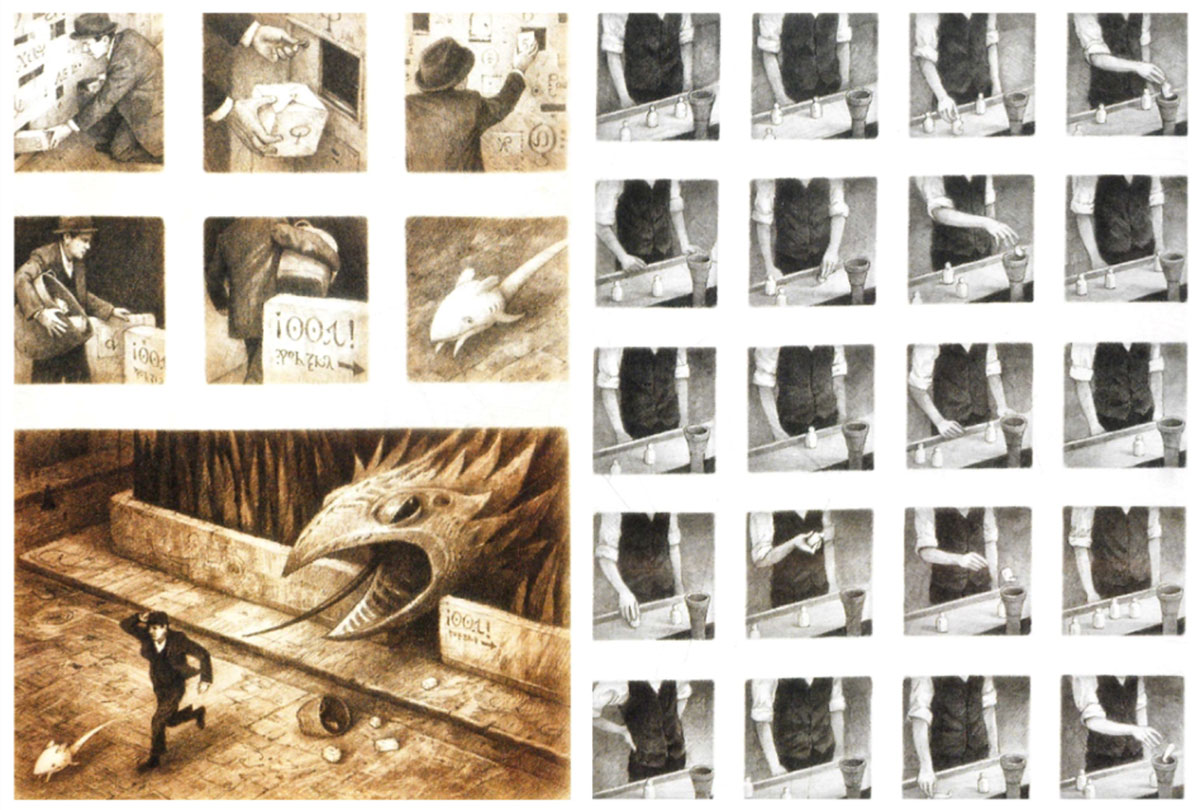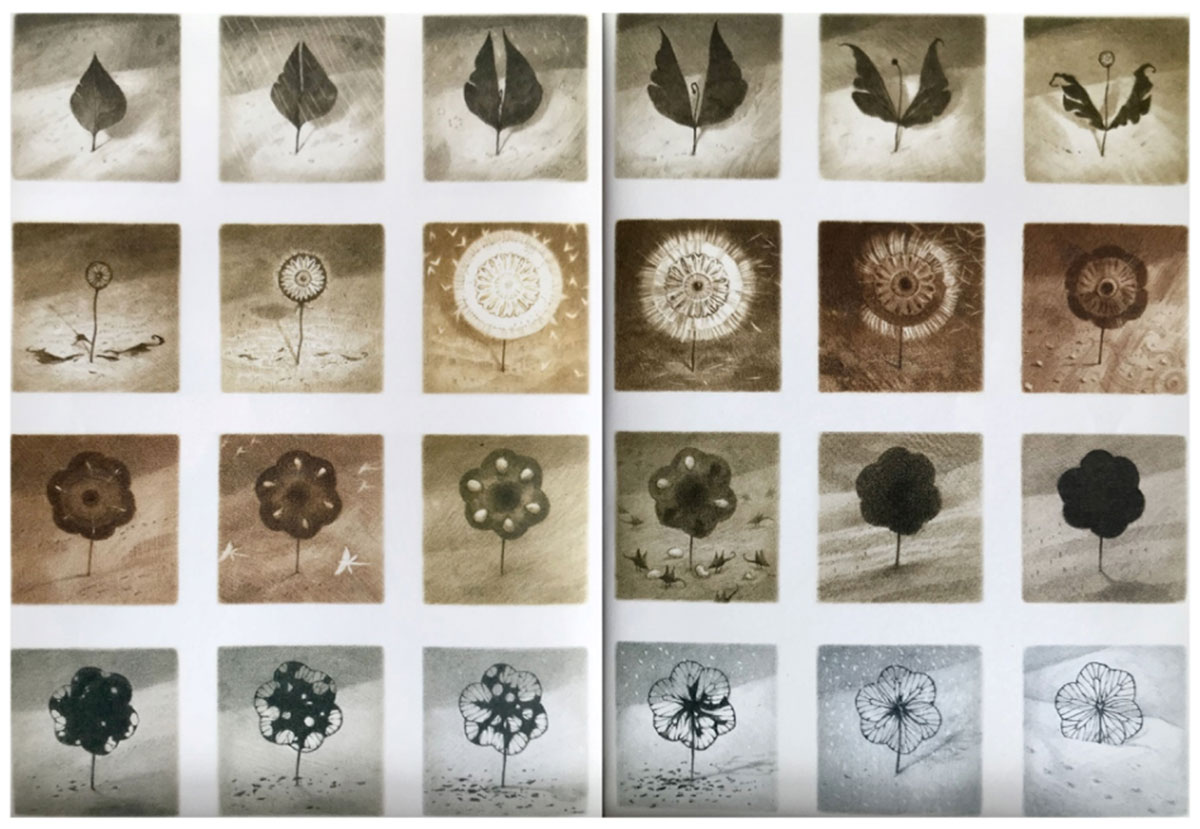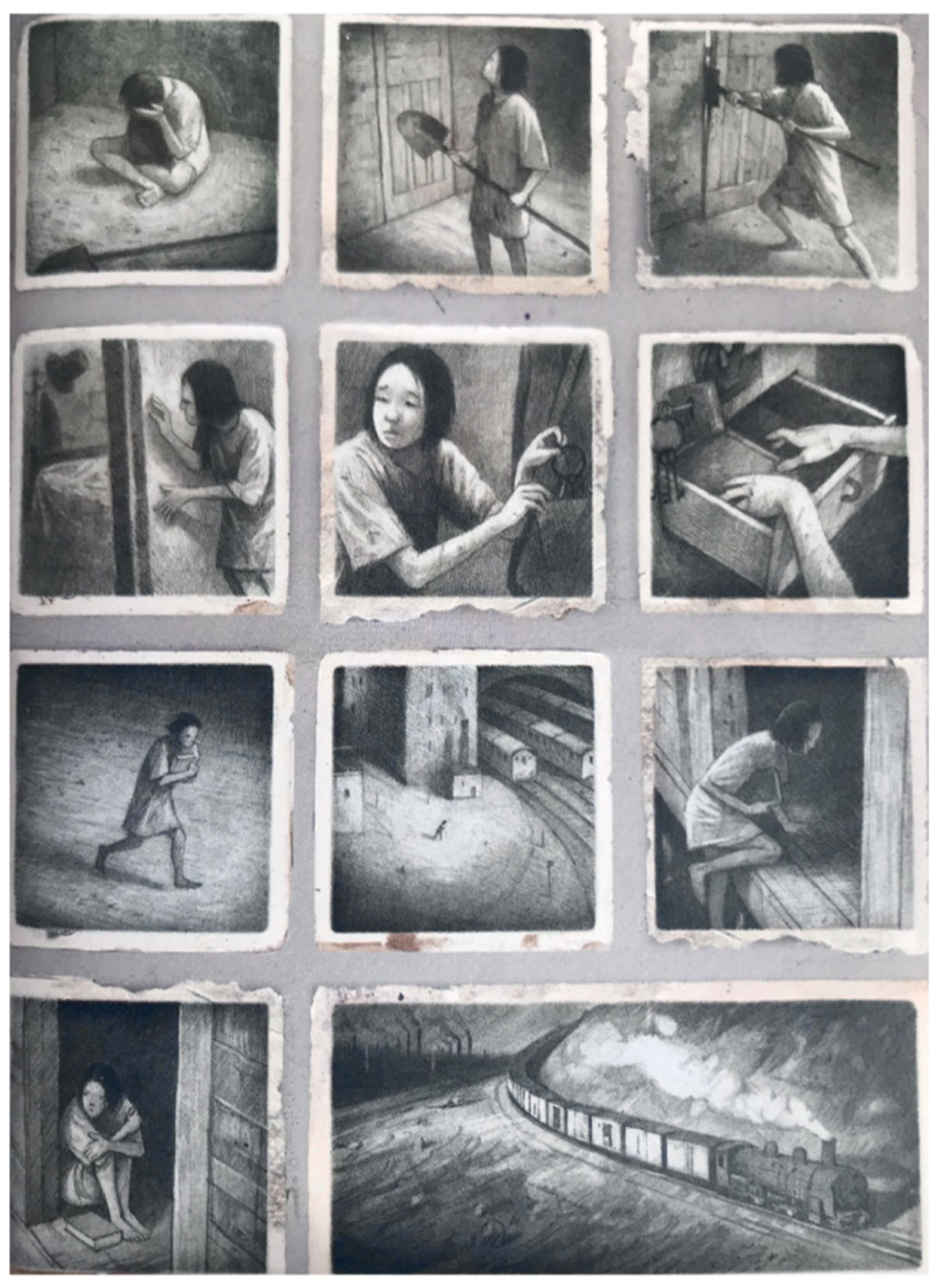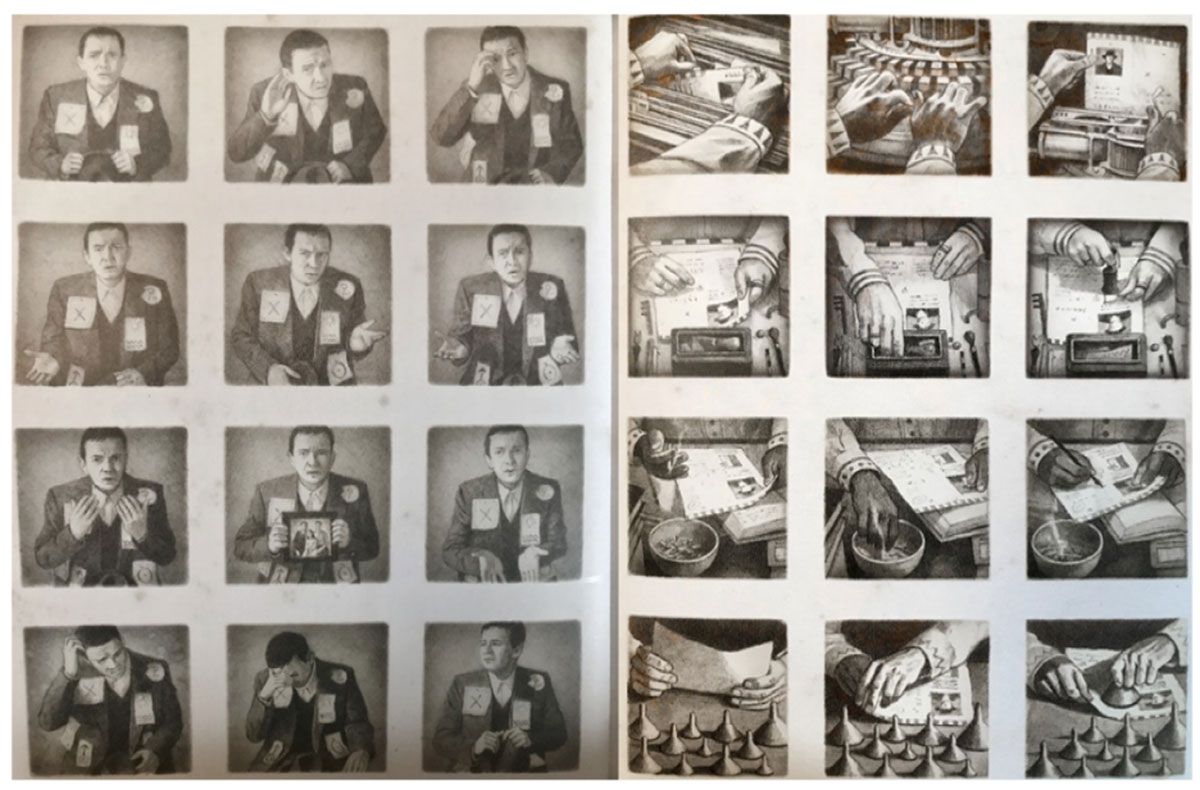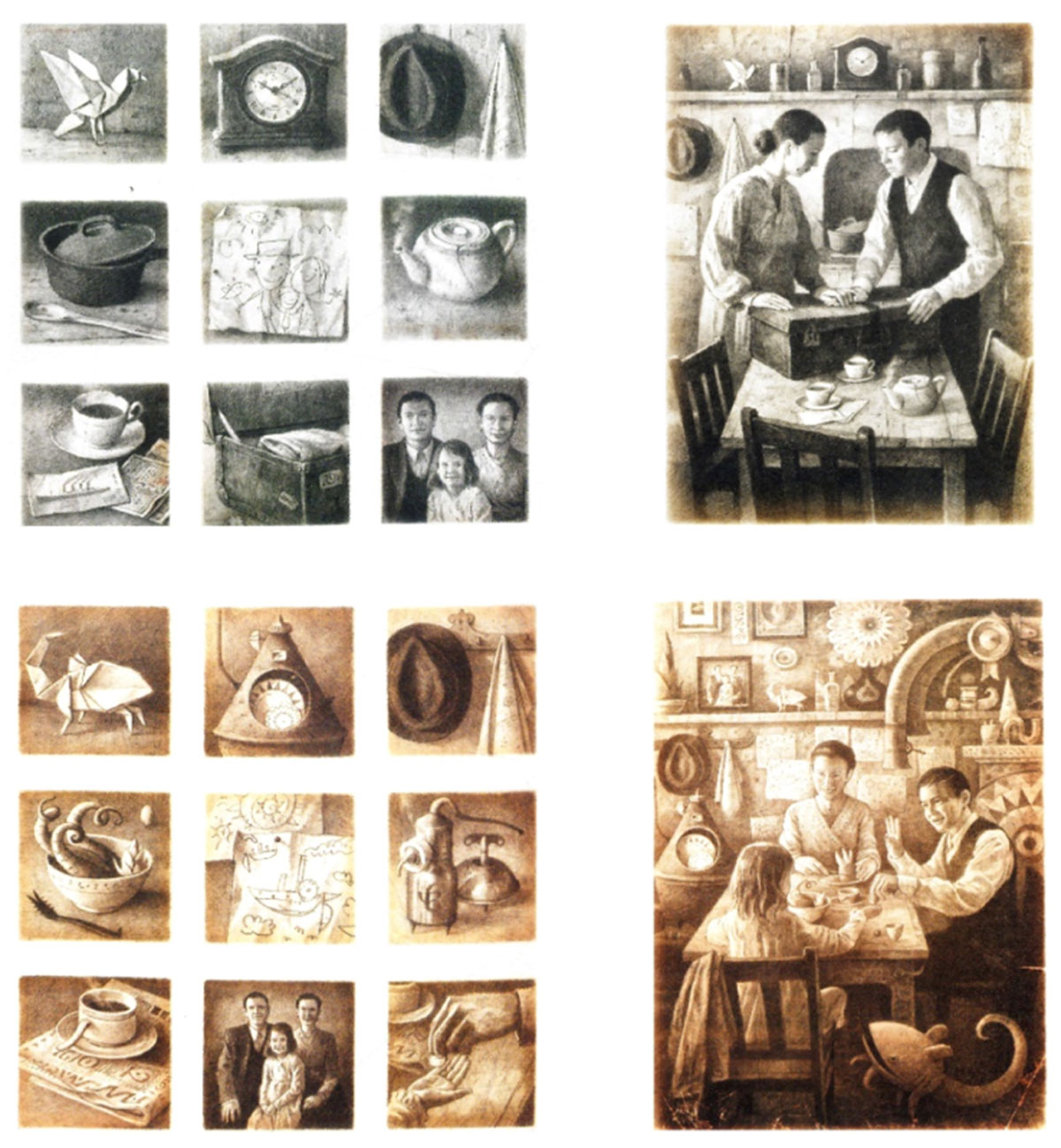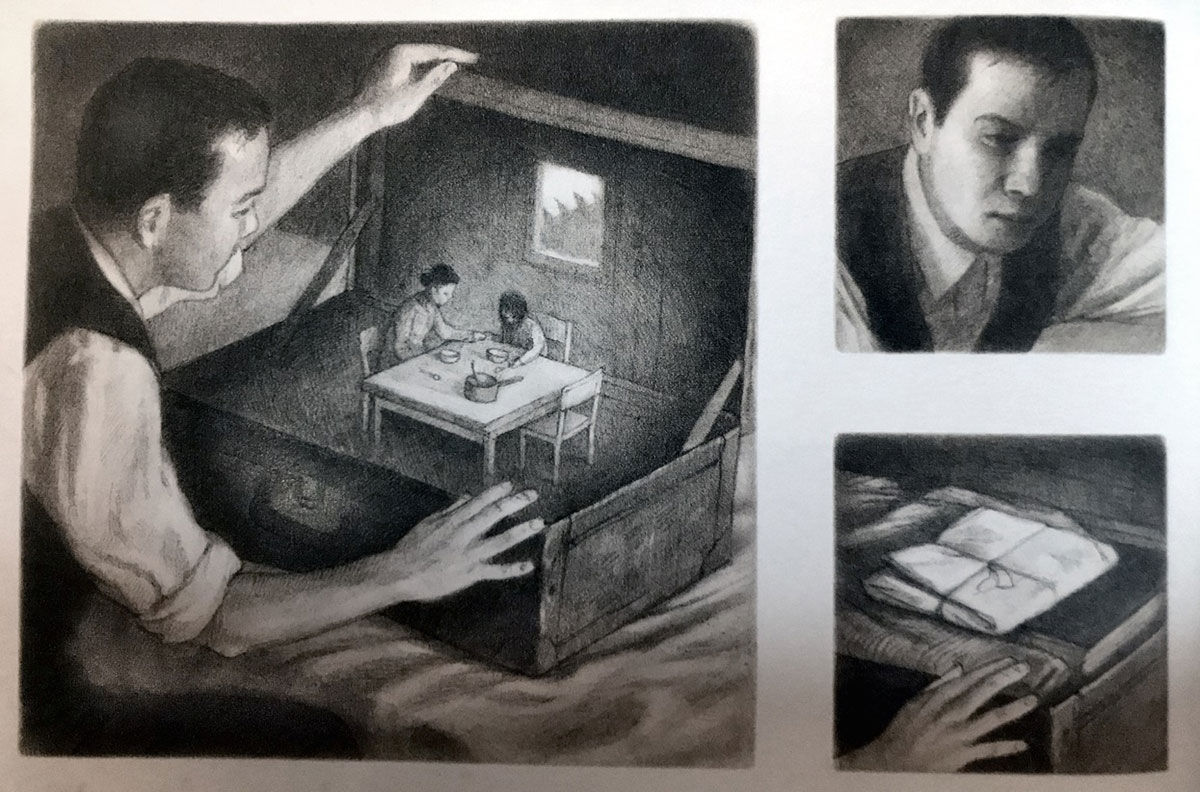Introduction
This essay focuses on a work that belongs to a subset of graphic novels, namely wordless graphic novels. Distant ancestors of this niche genre can be found in the works of German painter Otto Nückel and Flemish painter and graphic artist Frans Masereel, whose 1919 woodcut novel A Passionate Journey was a commercial success in Europe. While the early 20th-century U.S. canon primarily includes woodcut novelists—such as Lynd Yard and Giacomo Patri—the genre has been successfully incorporated into the comics medium in the last few decades thanks to visionary artists like Eric Drooker (Flood!: A Novel in Pictures, 1992) and Peter Kuper (The System, 1997).
Among the contemporary wordless graphic novels in the medium of comics, Australian artist and award-winning filmmaker Shaun Tan’s 2006 work The Arrival stands out as direct and easily readable. This is a remarkable achievement if one considers that Tan’s visual style has been described as ‘decidedly antinaturalistic’ (Groß 2013: 205) and that he creates a vaguely steampunk world crammed with strange pets, unintelligible languages, and weird objects, whose behavior appears as much unpredictable to the protagonist as to the book’s viewers. Tan, whose father was himself a Chinese/Malaysian immigrant, tells the story of an everyman who is forced by an obscure, oppressive power to leave his family and relocate to a strange new land, with all the problems that migration and resettling bring about. At the end of the book, though, the protagonist is finally able to reunite with his family in the new country, where his little daughter seems to be adapting way faster than he did.
Since wordless graphic novels necessarily ‘flout comics’ central element of word-image relation’, as Florian Groß reminds us (2013: 197), they need to rely heavily on the visual narrative means available in comics. Tan’s narrative use of the visual features of comics is what makes The Arrival an exemplary work of purely graphic storytelling. However, although Tan’s peculiar drawing style has been widely praised, little has been written on Tan’s graphic choices as a medium-specific means to tell a story. Constitutive features of comics, such as frames, gutters, and panels, as well as graphic choices like coloring, texture, and lines all play a crucial role in The Arrival’s narrative economy; this essay specifically focuses on how they affect two crucial aspects of the narrative, that is, the representation of time and focalization.
Time as Space in The Arrival
As most comics scholars and artists agree, ‘the form’s fundamental syntactical operation is the representation of time as space’ (Chute & DeKoven 2006: 769). This is why a narratological approach to comics needs to account for the peculiar spatial organization of the pages.
The very first issue concerning the spatial representation of time in comics is the definition of the elementary unit of analysis—a problem familiar to literary scholars too. Since there is no stable equivalent of verse or sentence in the visual language of comics, however, most scholars consider the panel as the minimal element of analysis (Groensteen 2007: 24–25). Groensteen provides us with a tight definition of panels, which has the merit of clarifying why it is convenient to privilege them as elementary units of analysis:
In its habitual configuration, the panel is presented as a portion of space isolated by blank spaces and enclosed by a frame that insures its integrity. Thus, whatever its contents (iconic, plastic, verbal), and the complexity that it eventually shows, the panel is an entity that leads to general manipulation.
(2007: 25, italics mine)
However, panels alone do not tell us the whole story. Comics are made up of static images; therefore, any event with a certain duration—be it dream, thought, or action—needs to be broken down into series of panels which, as Belgian comics expert Pascal Lefèvre observes, ‘reduce the chronological timeline of the fabula to selected and fragmented units’ (2011: 23). Thus, panels single out and combine the events of the story. In other words, they are responsible for the sequencing of the story and this, in turn, is what makes them relevant to a narratological analysis of comics. Moreover, by informing the visual reception of panels, frames and gutters provide viewers with fundamental narrative information well before they dive into the panel content (see the discussion of Figure 3).
In fact, comics are as much about what is represented as they are about what is not visible on the page (Chute 2008: 455); therefore, readers need to fill in the gaps in the gutters between the panels (see Postema 2013 for a thorough discussion of gaps) to lend meaning to the narrative. Of course, this implies that ‘the more distinct the content of adjacent panels, the more difficult it will be for readers to make sense of a panel sequence’, as Lefèvre remarks (2011: 29). This, in turn, accounts for the distinct narrative values possessed by different transitions between panels. For example, the amount of time elapsing between two panels may be extremely complex and occasionally even impossible to determine, revealing the fundamental role of ellipses in graphic storytelling.
In narratological terms, ellipses constitute the main operational feature of comics, as they occur in each and every gutter between panels. However, one must at least distinguish between implicit and explicit ellipses. Implicit ellipses are those in which an indefinite amount of time goes by between two scenes, whereas, in explicit ellipses a definite amount elapses between two scenes (Genette 1980: 106).
Let us consider now Figure 1, which shows two pages following one another recto-verso in The Arrival. In Figure 1, an implicit ellipsis occurs between the bottom panel of the page on the left-hand side and the panel on the upper-left corner of the page on the right-hand side. This implicit ellipsis reveals a further ambiguity, as there are no formal clues helping viewers determine which of the two sequences occurs first in the story. The two pages are held together by means of their thematic kinship, since both belong to a broader series that pivots around the protagonist’s clumsy attempts to secure and keep a job in the new country.
Implicit ellipsis. Tan, S. 2007 The Arrival © Shaun Tan, 2006, 2014.
Alternatively, a fascinating example of explicit ellipsis can be appreciated in Figure 2. This double-page spread shows viewers that twelve months have elapsed in the narrative by means of a visual synecdoche, which stands for the changing of the seasons. The narrative resumes right after this image with another double-page spread showing a wintery cityscape, which helps the readers establish that a whole year has gone by.
Explicit ellipsis. Tan, S. 2007 The Arrival © Shaun Tan, 2006, 2014.
As regards the narratological role of panel transitions, I also need to emphasize that different types of frames and gutters may be used to highlight significant narrative passages (Mikkonen 2010: 77), all the more in a wordless graphic novel like The Arrival. The book’s pages look like those of an old family album. As regards the hyper-frame, which Groensteen defines as the exterior edge of the page that encloses the entire drawing board (2007: 30), its off-white color as well as patchy graphic texture reinforce the allegory of the photo album, hinting at the embodiment of a collective memory—that of migration—in an individual biography. Although frames tend to be thin and gutters are homogeneous throughout most of the book, every time Tan desires to emphasize a narrative passage, he makes use of roughened, irregular frames and visually alters the gutters as well. In The Arrival, this can be appreciated in every flashback sequence. For example, let us take a look at Figure 3 below.
Young girl’s flashback sequence. Tan, S. 2007 The Arrival © Shaun Tan, 2006, 2014.
The crumbly and disrupted texture of the frames deftly signals that the panels’ content refers to memories of events which took place well before the time of the primary plotline. The gray color palette of the page, which contrasts with the predominantly sepia-toned palette of most of the book’s pages, functions as an additional clue which reminds viewers that the whole sequence is set in a different temporal as well as spatial dimension.
The order in which events are narrated in a narrative can be very different from the order of the events as they happen in the story (Genette 1980: 35). Since in wordless graphic novels there is no equivalent of temporal adverbs or verbal tenses to signal shifts through different time dimensions, one might assume that the time of the story merely follows the order of panels. However, this is hardly the case in The Arrival, where several analepses occur in the narrative. There are three flashback sequences in the book, each of which is introduced by visual modifications of the frames, the gutters, and the coloring (Figure 3); moreover, these sequences are all opened by a panel zooming in on a character, which marks the shift to internal focalization occurring in each flashback. As Silke Horstkotte and Nancy Pedri write, focalization is an effective means to provide ‘crucial links between a first narrative and analepses’ (2011: 343). Indeed, in The Arrival, the shift to internal focalization offers a narrative clue that helps viewers orientate themselves through the wordless transition to the flashback sequence.
I believe that, from the point of view of the book’s narrative economy, the main purpose of the three analepses in The Arrival is to give these episodes a meaning they do not have in and of themselves. In fact, taken individually, the flashback episodes are stories of escape from dangerous and oppressive situations. However, the recollection of those past moments occurs in response to the protagonist sharing some details of his own migration experience. The focalizing characters in the flashbacks are themselves migrants who resettled in the new country. Furthermore, they are the only people in the new country with whom the protagonist shares parts of his story, and they all help him out in different ways. As a result, I think that the three episodes need to be interpreted in the light of what is happening in the primary plotline, that is, they stand for moments of solidarity between the protagonist and the other migrants.
Besides being responsible for the sequencing of the story, panels also structure the reading process, which in comics can occur in multiple directions, often defying narrative linearity (Chute 2008: 460). This is a medium-specific property of panels which needs to be addressed in a narratological analysis of comics because it affects the narrative rhythm. In The Arrival, most pages display a regular grid of four tiers, each of which is made up of three square panels. Even in the few pages where Tan uses a slightly different grid, panels always find themselves located in a very precise site within the hyper-frame of the page. The degree of narrativity of the panels is thus greatly influenced by the position they occupy on the page. The upper-left corner, the center, and the lower-right corner of the page are possibly the most significant positions, as it is in these sites that major changes in the temporal dimension of the narrative occur.
For example, let us consider again the lower-right panel of Figure 3. I argue that its position contributes to the viewer’s awareness that that is the ending panel of the flashback sequence. Had that very panel been placed in the center or in the upper-left corner of the page, it would not have possessed the same degree of narrativity. In fact, the gutter separating the panel in the lower-right panel from the upper-left panel in the next page bears more narrative significance than any other—it being the very space supposed to urge viewers to move on to the next page. It is no coincidence, then, that each of the three flashbacks included in The Arrival is introduced by a panel lying in the lower-right corner of the page.
Although panels doubtless constitute the elementary units of analysis in any narratological approach to comics, one needs to bear in mind that, in terms of page composition, comics artists often think of the double page as the ‘pertinent unit’ (Groensteen 2007: 35). In other words, artists are aware that the double page is the space where viewers may cast their gaze in one look when turning a page—at least in a book or magazine format. That is why they might want to arrange the spatial organization of panels accordingly. For example, the sequence where the protagonist of The Arrival goes through the border control is based on this compositional principle (Figure 4).
The border control sequence. Tan, S. 2007 The Arrival © Shaun Tan, 2006, 2014.
In a series of drawings resembling medium close-up shots on the left side of the double page, one sees the man standing, facing the viewer as he tries to interpret what an immigration officer is telling him. The page is mirrored on the right side, although this time viewers look at the officer’s hands as if through the protagonist’s eyes, thanks to a change in the visual focalization. The tight narrative rhythm of this passage is partly a product of such a mirroring effect, which helps build up the dramatic tension of the sequence. In fact, the rhythm would be less cadenced were the two pages printed recto-verso, because of the break in the reading process caused by the page turning.
Finally, another property of panels which Tan plays around with is size. As I mention above, in The Arrival panels are arranged in a regular grid. It is precisely this regularity that makes size variation a significant parameter. However, changes in the panels’ size are mostly limited to the use of full-page panels as well as double-page spreads, which never exceed the limits of the hyper-frame. What narratological functions do these peculiar types of panels carry out in the book?
Firstly, they play a compositional role in terms of the mise en scène. In The Arrival, viewers usually find full-page panels and double-page spreads at the end of certain sequences of panels, in which details of a place—and/or of an action—are zoomed in on or displayed from quite unusual angles, typically with aspect-to-aspect transitions between the panels. The cognitive effort required to make sense of these details creates a tension that full-page panels and double-page spreads help release, providing an overview of the action/place showed in the previous sequence, which in turn helps viewers interpret it. Secondly, these panels alter the narrative rhythm, most times with the effect of slowing it down, thus functioning as an equivalent of digressions in written literature (Mikkonen 2008: 304). However, slowing down the narrative rhythm is by no means a prerogative of large panels only. For instance, if we consider the right-hand page of Figure 1, the narrative rhythm is successfully slowed down using a higher number of smaller panels, which successfully convey the drudgery of a factory job. On a side note, it is worth noting that the tedium and the slowness of the sequence are also emphasized by Tan’s choice of a gray palette. Moreover, the panels only show the protagonist’s body and the conveyor belt he is working at—his head is deliberately left out of the images—so as to suggest that the job does not require the worker to use his brain at all.
I now need to address the last aspect of panels’ narratological function, which concerns the degree of narrativity of panels’ content. Comics scholar Kai Mikkonen distinguishes between two different functions of panel images:
The picture function of the panel [fonction-tableau] is, in other words, that which strives to focus the viewer’s attention on a particular image by isolating it from the rest of the story, thus urging the viewer to spend more time with it.
The narrative function of the panel [fonction-recit], however, is that which makes the spectator glide over the image, viewing it as merely part of the narrative continuum.
(2010: 82)
Although scholars and authors from different backgrounds might label the two functions identified by Mikkonen differently, there is shared consensus about the twofold nature of panel images (Baetens 2008: 80). However, when it comes to wordless graphic novels, it can be fairly complicated to draw a line between narrative and non-narrative images. Instead, it is more convenient to think in terms of the creative friction between narrative elements and non-narrative elements within the image (Baetens 2008: 82).
For instance, let us take a look at the following sequence from The Arrival, in which the viewers can appreciate how the technique of vectorization is employed to emphasize a narrative element in the last two panels (Figure 5). Vectorization is used to give lines, objects, and characters in a drawing a certain direction in order to suggest forward motion, which in turn may evoke the illusion of time passing.
An example of vectorization—left to right with respect to the reader—in the last two panels. Tan, S. 2007 The Arrival © Shaun Tan, 2006, 2014.
Although there is hardly any doubt that in comics narration is the product of the succession of still images, there nonetheless exists a limited range of drawing techniques that can be employed to express the narrative potential of the panel image. Vectorization, zooming, and panning, for instance, all belong to the most common means used to evoke the illusion of the passing of time within the borders of the panel. In conclusion, while it is true that still images cannot properly tell a story but only evoke one (Groensteen 2007: 23; Postema 2013: 17), they are nonetheless able to express a certain degree of narrativity by means of freezing movement at key stages (Mikkonen 2010: 75).
Configurations of Temporality
The narratological analysis of panels I have carried out so far constitutes the basis for further reasoning on the configurations of temporality in The Arrival. Paul Ricoeur considers ‘temporality to be that structure of existence that reaches language in narrativity and narrativity to be the language structure that has temporality as its ultimate referent’ (2004: 327). Thus, since time is not a narrative structure per se, narratives prompt viewers/readers to (partly) reconstruct the temporal dimension of the story through that of the narrative, as it is configured in the text (Genette 1980: 33). How do narratives achieve such a result? First and foremost by means of the plot.
In narratology, the plot is typically thought of as the device that conceptually organizes the events of the story in the narrative, with an emphasis on causality (Forster 2005: 85). However, Paul Ricoeur takes a slightly different stance on the topic; he understands narrative as a combination of two complementary aspects—the episodic and the configurational dimension. As regards the plot, he sees it as the organizational principle that arranges the chronological episodes, making the story unfold in the way postulated by the narrator. In the French philosopher’s own words:
[…] every narrative combines two dimensions in various proportions, one chronological and the other non-chronological. The first may be called the episodic dimension, which characterizes the story as made out of events. The second is the configurational dimension, according to which the plot construes significant wholes out of scattered events. […] I understand this act to be the act of the plot, as eliciting a pattern from a succession.
(2004: 335, italics mine)
If we attempt to apply Ricoeur’s conceptualization to the analysis of The Arrival, we find that each panel sequence used to represent an event can be thought of as an instance of the episodic dimension, whereas the plot can be seen as the instance organizing more or less distant panel sequences into series, according to the medium-specific principle of braiding.
Braiding is the effect brought about by the repetitions-with-a-difference occurring in comics ‘between spatially distant images’ (Groensteen 2013: 35). Telling a story without words implies that the repetitions of frames, motifs, body postures, angles, and colors all shape the relations in praesentia as well as in absentia between more or less distant series of panels. This essentially means that the repetition of motifs as well as other elements may urge viewers to go back to previous series of panels in order to interpret the meaning of the graphic reverberation brought about by the repetitions. The following sequences from The Arrival (Figure 6) provide a good example of how the plot allows the configurational dimension of narrative to emerge by means of the braiding effect.
Opening sequences of the first as well as last chapter of The Arrival. Tan, S. 2007 The Arrival © Shaun Tan, 2006, 2014.
It is worth noticing that these sequences present the same structure—a page with nine square panels arranged in three tiers followed by a full-page panel. In addition, slightly modified motifs repeat themselves through the panels. However, repetitions in comics can never be perfect reproductions, even though two panels were strictly identical, if only because of the ‘citation effect that is attached’ to them, as Groensteen remarks (2007: 148). Thus the visual repetition of structures and motifs is a powerful means through which the configurational dimension of the narrative can emerge out of single episodes. But what is exactly the narrative significance of these repetitions?
The two sequences above open the first and the last chapter of the book, respectively. According to semiotician Yuri M. Lotman, the beginning and the end of a text are the main segments where the processes of encoding and decoding occur (1972: 261). Taking this line of reasoning further, I argue that the two sequences shown in Figure 6 function as a frame of reference. They encompass all the changes brought about by the story of migration and resettling—symbolized by the modifications in the furniture as well as the differently shaped paper animals—embedding them in a narrative of family reunion. The different coloring of the panels helps signal the shift in the connotation of the two episodes—from the cold and tense atmosphere of the first sequence to the happy and cozy domesticity of the second one. In this way, the plot provides a configuration of directionality, if not even purpose, to the mere succession of events in the story (Ricoeur 2004: 336).
Focalization
In the fifth chapter of Narrative Discourse, Gérard Genette urges his readers not to ‘confuse the two instances of the focalizing and the narrating’ (1980: 246) in a narrative. He identifies the focalizer and the narrator as the instances answering the two questions “who sees” and “who speaks” in a narrative, respectively.
In the case of The Arrival, identifying the narrating instance does not seem to be particularly problematic. If we understand the narrator as the instance responsible for the selection of the images and their organization in series of panels—according to the formal principles as well as the configurations of temporality I have discussed above—then the book features an extradiegetic covert narrator. Its presence becomes explicit only through a close analysis of the configurational dimension of the narrative—as shown in Figure 6.
On the contrary, finding a narratological definition of focalization that appears suitable for the study of this wordless graphic novel proves to be more difficult. While Genette’s model is helpful to bypass confusing terms such as “perspective” or “point of view”, his conceptualization suffers from a significant limitation, that is, he mainly understands focalization as a function of visual perception. In this way, though, the important meaning-making function of focalization in narrative is neglected (Horstkotte & Pedri 2011: 332–334).
At this point, however, I need to draw a further distinction between the concepts of perceptual and cognitive focalization in graphic storytelling. Mikkonen defines perceptual focalization as the operation that provides a ‘spatially determined point of perception’ (2015: 105), which is absolutely necessary since in comics viewers cannot approach panels but ‘from a specific angle and from a specific distance’ (Groensteen 2010: 2). Cognitive focalization, on the other hand, stands for the graphic representation of inner states of consciousness. In Mikkonen’s words, cognitive focalization allows viewers to assess ‘how and to what extent the image, and what is seen in the image, is subjectivized by narrative conventions and context and associated with the perception and consciousness of a character in the storyworld’ (2015: 106, my italics). Although Mikkonen calls for ‘a systematic assessment of the distinction between perceptual and cognitive focalization’ in graphic narratives (2015: 110), I consider a thorough disentanglement of these two dimensions to be virtually impossible. That being said, it is still worth attempting to clarify the modalities in which both aspects contribute to mediating the relationship ‘between the vision and what is perceived’ (Mikkonen 2012: 76).
As a result, I should like to refer to Horstkotte and Pedri’s broader definition of focalization. The two scholars define focalization as a ‘relational operation’ that binds a focalizing actor to a focalized object, and they specify that such relation does not necessarily pass through the filter of optical ‘perspectivation’ (Horstkotte and Pedri 2011: 351). Bearing this definition in mind, I will proceed now to consider the three modes of focalization that I have identified in The Arrival.
Character-bound Focalization
The first mode is character-bound focalization. In this case, viewers are able to see as if through the focalizing lenses of a character’s eyes—in a way analogous to what film scholars label a first-person shot (or POV shot). In The Arrival, examples of this modality can be appreciated in Figure 4. As regards cognitive focalization, however, Horstkotte and Pedri correctly remind us that ‘the focalizer does not have to coincide with the consciousness being presented’ (2011: 335). In fact, while on the left-hand side of Figure 4 the focalizing character is the immigration officer, it is nonetheless clear that the whole sequence is showed as filtered by the book’s protagonist’s inner state of consciousness. This way, although the viewers share the visual perception of an emotionless bureaucrat, they at the same time perceive the baffling bewilderment and the fear which permeate the protagonist’s consciousness as well as the whole double-spread.
Non-character-bound Focalization
Panels can also be focalized through a non-character-bound focalization, which neither overlaps with that of a character nor necessarily focuses on a character. A good example of this mode of focalization can be found in Figure 2. Mikkonen understands this focalizing instance as a vague ‘non-character bound external focalizer’ (2015: 310), though I would say that this modality allows the narrator’s cognitive focalization to surface. Let us consider again Figure 6 for a moment. The images are evidently an example of non-character-bound focalization, as the focalizer does not coincide with any of the characters. As I write above, the different coloring of the panels signals the shift from the negative connotation of the first episode to the positive connotation of the second one. However, since color is also a crucial marker of focalization in comics (Horstkotte and Pedri 2011: 333), I argue that the different color palettes reveal the narrator framing the two episodes as a negative and a positive one, respectively. This is a judgment expressed by purely visual means, which viewers adopt when they look at the panels.
Intermediate Focalization
The last mode of focalization I was able to identify in The Arrival is a form of partially subjective focalization, thus representing an intermediate stage between the two cases illustrated above. This modality occurs when viewers look at a panel from a point of perception that belongs to no character and yet is partially subjective (Mikkonen 2008: 310). This type of focalization is close to the character-bound focalization, without fully coinciding with it. As a result, viewers enjoy a point of visual perception that does not belong to the character and yet is subjectified; therefore, I call it intermediate focalization. Although it is not necessarily associated with a character’s consciousness, the intermediate focalization is a powerful way to engage viewers by means of character-bound cognitive focalization, as one can appreciate below in Figure 7.
Viewers see the content of the suitcase as the protagonist sees it in his mind. Tan, S. 2007 The Arrival © Shaun Tan, 2006, 2014.
Character-bound cognitive focalization plays a crucial role in a wordless work like The Arrival, which neither allows characters to speak for themselves, nor grants viewers access to their thoughts in any linguistic form. In Figure 7, viewers are able to get access to the protagonist’s inner consciousness for a moment. Therefore, this sequence of panels is able to match an ‘act of showing’ with a ‘form of thinking’ (Mikkonen 2008: 319). From a narratological standpoint, the intermediate focalization is an essential feature of comics, because it crucially helps the narrative do without the mediation of written language. Thanks to this mode to focalization, viewers are able to correctly interpret the content of the panel on the left-hand side of Figure 7 as a trace of what the character is thinking and seeing in his mind. In fact, I argue that, if that very panel had been focalized through pure character-bound focalization, the relationship between the focalized objects and the focalizing consciousness would have been more opaque.
Conclusions
In this essay, I have adopted a medium-specific approach to offer a narratological analysis of Shaun Tan’s wordless graphic novel The Arrival. As comics scholars have been claiming over the last two decades, understanding graphic and visual solutions as medium-specific tools to represent narrative time and focalization could possibly help narratology finally move ‘beyond the categories […] that are solely based on literary examples’ (Mikkonen, 2008: 319). In fact, theories born out of literary narratology cannot but reveal a certain narrowness of scope when applied to the study of graphic narratives, mainly due to the different nature of their objects of study.
I have attempted to shed light on some of the means, the devices, and the solutions that a work like The Arrival employs to successfully narrate a story without relying on written language. While it is true that the representation of time as space is a common feature of all narratives in the comics medium, each graphic narrative structures time in a different way. Since The Arrival is a wordless graphic novel, the panels’ properties—frames, gutters, size, color—crucially help establish the order of the events and allow a great variability when it comes to the representation of the amount of time elapsing between two panels. In The Arrival, the order of the events is made intelligible to the viewers by means of visual modifications of the frames and gutters predominantly used throughout the book as well as by means of different modes of focalization. In addition, my analysis of panels’ size variation throughout the book reveals how the narrative rhythm can be altered by using double-spreads or by increasing the number of panels to decrease the rhythm of the narration—as in Figure 1.
The Arrival also provides a good example of how temporal structures affect the narrative’s meaning-making process. This results from my analysis of the flashback sequences as well as the opening sequences of the first and last chapters of the book, respectively. These sequences clearly show the visual implications resulting from the action of the plot, which allows a configurational dimension of narrative to emerge. This latter dimension, in turn, allows the viewers to interpret the ending of the story in the light of the beginning and vice versa.
Finally, in the last section of the essay, I have provided a typology consisting of three different modes of focalization used in The Arrival. In doing so, I have attempted to bring together the concepts of perceptual and cognitive focalization, in an effort to bypass more traditional, schematic models which rely mainly on visual perspectivation (see Horstkotte & Pedri 2011). In this regard, The Arrival’s fascinating mix of different modes of focalization can contribute to broadening our understanding of the very concept.
Acknowledgements
I would like to thank Lucilla Gingilli for introducing me to The Arrival as well as to Shaun Tan’s work in general. I am also very grateful to Dr. Thomas Dikant for his encouraging comments and to Francesco Saverio Sani for his helpful feedback. Of course, any possible mistake is to be attributed only to the author.
Competing Interests
The author has no competing interests to declare.
Author’s Note
Every effort has been made to trace copyright holders and to obtain their permission for the use of copyright material under educational fair use/dealing for the purpose and criticism and review and full attribution and copyright information has been provided in the captions.
References
Baetens, J 2008 Graphic Novels: Literature without Text. English Language Notes, 46(2): 77–88. DOI: http://doi.org/10.1215/00138282-46.2.77
Chute, H 2008 Comics as Literature? Reading Graphic Narrative. PMLA, Vol. 123, No.2, pp.452–465. Available at: https://www.jstor.org/stable/25501865. DOI: http://doi.org/10.1632/pmla.2008.123.2.452
Chute, H., DeKoven M 2006 Introduction: Graphic Narrative. Modern Fiction Studies, Vol. 52, No. 4, Graphic Narrative Special Issue, pp. 767–782. Available at: https://www.jstor.org/stable/26286669. DOI: http://doi.org/10.1353/mfs.2007.0002
Forster, E. M 2005 Aspects of the Novel, Penguin Classics.
Genette, G 1980 Narrative Discourse, Translated by Jane E. Lewin, Blackwell.
Groß, F 2013 Lost in Translation: Narratives of Transcultural Displacement in The Wordless Graphic Novel. In: Stein, D., Denson, D., Meyer, C., (Eds.) Transnational Perspectives on Graphic Narratives: Comics at the Crossroads, London: Bloomsbury Academic, pp. 197–210.
Groensteen, T 2007 The System of Comics. Translated by Nick Nguyen and Bart Beaty, University Press of Mississippi.
Groensteen, T 2010 The Monstrator, the Recitant, and the Shadow of the Narrator. European Comic Art, Vol. 3, No.1, pp. 1–21. DOI: http://doi.org/10.3828/eca.2010.2
Groensteen, T 2013 Comics and Narration, Translated by Ann Miller, University Press of Mississippi. DOI: http://doi.org/10.14325/mississippi/9781617037702.001.0001
Horstkotte, S., Pedri, N 2011 Focalization in Graphic Narrative. Narrative, Vol. 19, No. 3, pp. 330–357. Available at: https://www.jstor.org/stable/41289308. DOI: http://doi.org/10.1353/nar.2011.0021
Lefèvre, P 2011 Some Medium-Specific Qualities of Graphic Sequences. SubStance, Vol. 40, No. 1, Issue 124, pp. 14–33. Available at: https://www.jstor.org/stable/41300186. DOI: http://doi.org/10.1353/sub.2011.0007
Lotman, J. M 1972 La struttura del testo poetico, Eridano Bazzarelli (a cura di), Mursia & C.
Mikkonen, K 2008 Presenting Minds in Graphic Narratives. Partial Answers: Journal of Literature and the History of Ideas, Volume 6, Number 2, Johns Hopkins University Press, pp. 301–321. DOI: http://doi.org/10.1353/pan.0.0022
Mikkonen, K 2010 Remediation and the Sense of Narrative in Graphic Narratives. In: Goggin, J., Hassler-Forest, D. (eds.) The Rise and Reason of Comics and Comics and Graphic Literature: Critical Essays on the Form, McFarland & Company Inc., pp.74–86.
Mikkonen, K 2012 Focalisation in comics. From the specificities of the medium to conceptual reformulation. Scandinavian Journal of Comic Art (SJOCA), Vol. 1:1 (Spring 2012), pp. 72–94.
Mikkonen, K 2015 Subjectivity and Style in Graphic Narratives. In: Stein, D., Thon, J. (eds.) From Comic Strips to Graphic Novels: Contributions to the Theory and History of Graphic Narrative, De Gruyter, pp. 101–124.
Postema, B 2013 Narrative Structure in Comics: Making Sense of Fragments, RIT Press.
Ricoeur, P 2004 Narrative Time. In: Bal, M. (Ed.) Narrative Theory, Vol. III: Political Narratology, Routledge, pp. 327–347.
Tan, S 2007 The Arrival, Scholastic Inc.
